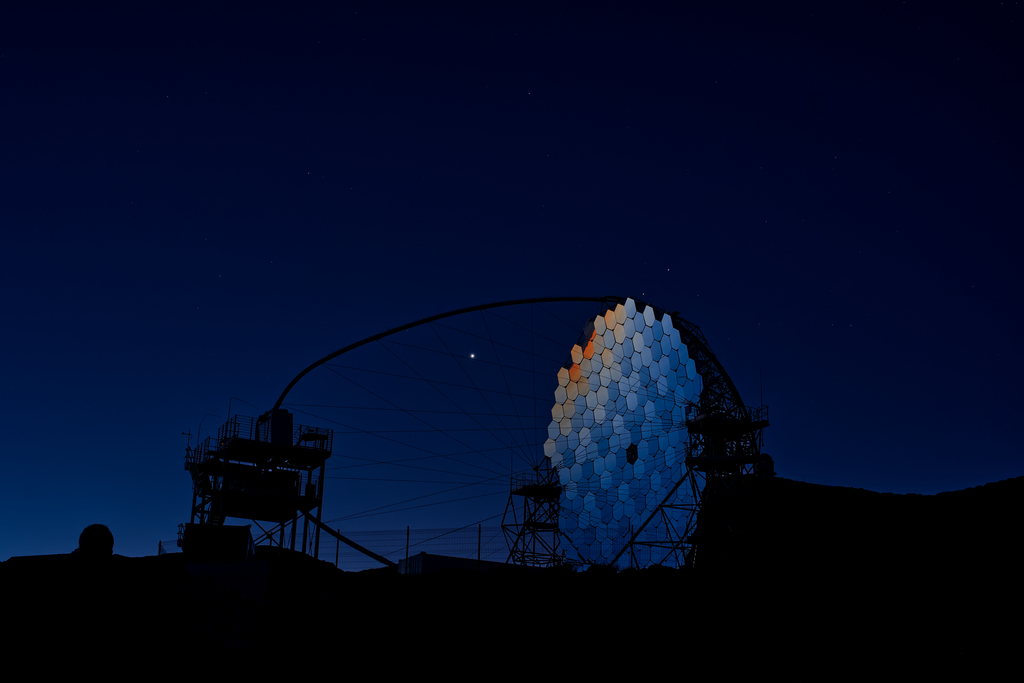What exactly are gamma-ray bursts?
Gamma-ray bursts are among the most extreme phenomena in the universe. In just a few seconds, they release as much energy as the Sun emits in its entire lifetime. The main burst lasts only a short time, from a few seconds to a few minutes. Then, we observe an afterglow that can fade over hours or even months.
We observe two types of GRBs: short or long ones, depending on their duration. Long GRBs occur during the explosions of exceptionally bright supernovae. Despite their immense luminosity, these extragalactic sources are exceptionally difficult to detect at the highest energies of the electromagnetic spectrum due to their location at cosmological distances and their rapidly fading emission.
The brightest gamma-ray burst ever observed
Cherenkov Telescope Array Observatory Large-Sized Telescope (CTAO LST) has published the results of observations of the brightest gamma-ray burst ever observed (named GRB 221009A) in the prestigious journal "The Astrophysical Journal Letters".
The observations were conducted in 2022 using a prototype called LST-1, during its commissioning phase, at the Roque de los Muchachos Observatory on the Canary Island of La Palma (Spain), at the northern site of the CTAO currently under construction. The observations revealed a signature of gamma-ray emission, shedding new light on the enigmatic and complex nature of gamma-ray bursts. The results confirm theoretical models that gamma-ray bursts originate in multi-layered jets that accelerate particles to relativistic energies.
Space observatories, including NASA's Fermi and Swift satellites, detected an extremely bright, long-duration gamma-ray burst called GRB 221009A on 9 October 2022. The burst, designated "BOAT" (Brightest of All Time), was so intense that many instruments observing it reached the end of their measurement scales, triggering further observations by instruments located around the world.
It all starts with a flash, or the study of a gamma-ray burst using the LST telescope
LST-1 began observing the event just 1.33 days after the initial explosion. LST-1's observations, spanning over 20 days, allowed the LST team to identify a signature of very high-energy gamma-ray emission. Although this signature did not reach the threshold required for formal detection, it allowed the team to establish tight constraints on the gamma-ray emission from this source. These results were compared with theoretical models of gamma-ray bursts jets.
Long gamma-ray bursts are thought to involve ultra-fast jets of plasma ejected either from a black hole or from the merging of neutron stars, in short GRBs. However, the exact process of jet formation remains a mystery. The LST-1 data supports the theory that GRB 221009A was powered by a complex, structured jet: a narrow, ultra-fast core surrounded by a wider, slower-moving sheath of material. This challenges the simpler “top-hat” jet commonly used in earlier studies and offers new insights into jet formation mechanisms and the nature of the central engine.
The observations were made under very bright moonlight, which poses a significant challenge for LST-type Cherenkov telescopes due to their sensitive cameras. The full moon in the hours after the outburst prevented the LST from immediately tracking GRB 221009A. However, technical solutions developed by the LST Collaboration enabled LST-1 to become the first Cherenkov telescope to observe this source.
Even more detailed research? It’s possible thanks to the new generation of CTAO telescopes
The results demonstrate the enormous potential of CTAO's next-generation telescopes to explore the Universe at very high energies, ushering in a new era in which scientists will be able to study the inner workings of cosmic sources in unprecedented detail.
Under the supervision of CTAO, three additional LST telescopes are currently being built by the LST Collaboration at the same site. Thanks to their unprecedented sensitivity, we will be able to study gamma-ray bursts and other extreme astronomical phenomena even before CTAO is completed.
What exactly is LST?
The LST is one of three types of telescopes that CTAO will use to observe a wide range of electromagnetic radiation, from 20 GeV (gigaelectronvolts) to 300,000 GeV.
Despite being 45 meters tall and weighing 100 tons, the LST can be aimed at any point in the sky in just 20 seconds. Both this rapid repositioning and the low energy threshold are crucial for studying variable sources such as gamma-ray bursts.
The CTAO LST, responsible for the design and construction of these telescopes, is making rapid progress on the construction of the CTAO Northern Observatory on the Spanish island of La Palma. The prototype LST telescope, LST-1, was inaugurated in 2018 and has been in the commissioning phase since then. Work is currently underway on the construction of three more LST telescopes, with completion scheduled for spring 2026.
Get to know CTAO!
CTAO will be the world's largest and most powerful observatory for gamma-ray astronomy. Its unparalleled accuracy and wide energy range (20–300,000 GeV) will help solve some of the most enigmatic questions in astrophysics, focusing on three main themes: understanding the origin and role of relativistic cosmic particles; studying extreme environments such as black holes and neutron stars; and exploring the frontiers of physics, searching for dark matter or deviations from Einstein's theory of relativity.
CTAO ERIC is responsible for the construction and operation of the Observatory. This group works closely with partners from around the world to develop the Observatory. Key partners include collaborations such as LST, which develop the necessary hardware and software, and the CTAO Consortium, an international group of researchers dedicated to the scientific use of the Observatory.
More information:
- https://www.ctao.org/news/lst-collaboration-paper-provides-new-clues-about-gamma-ray-burst-jets/ ;
- https://www.lst1.iac.es/index.html.
LST-1 Telescope
Source: Tomohiro Inada
Licence: CC BY-NC-ND 2.0
Edit: Press Office, University of Lodz

